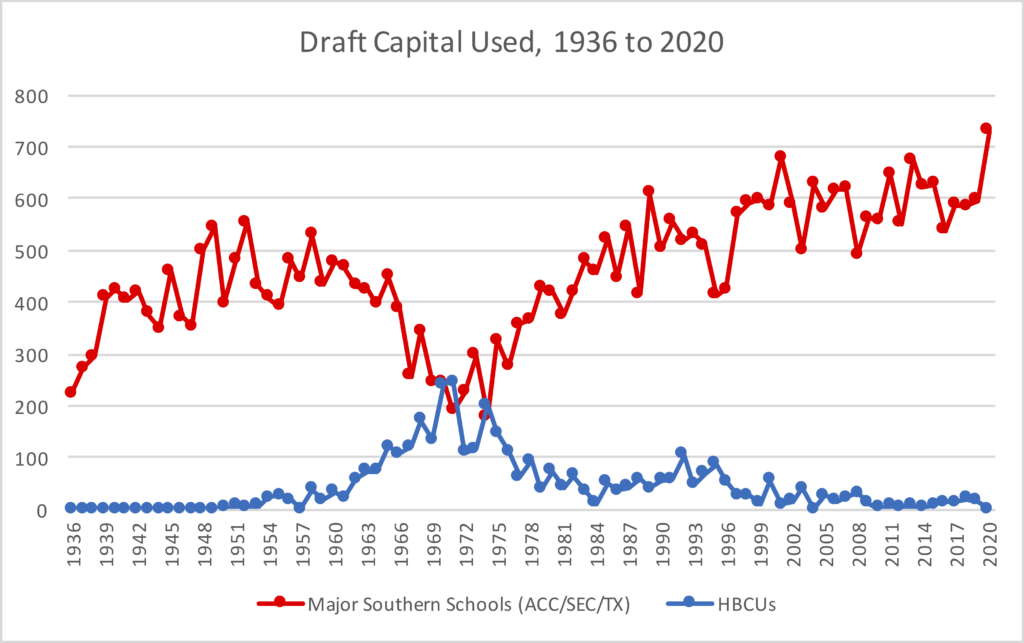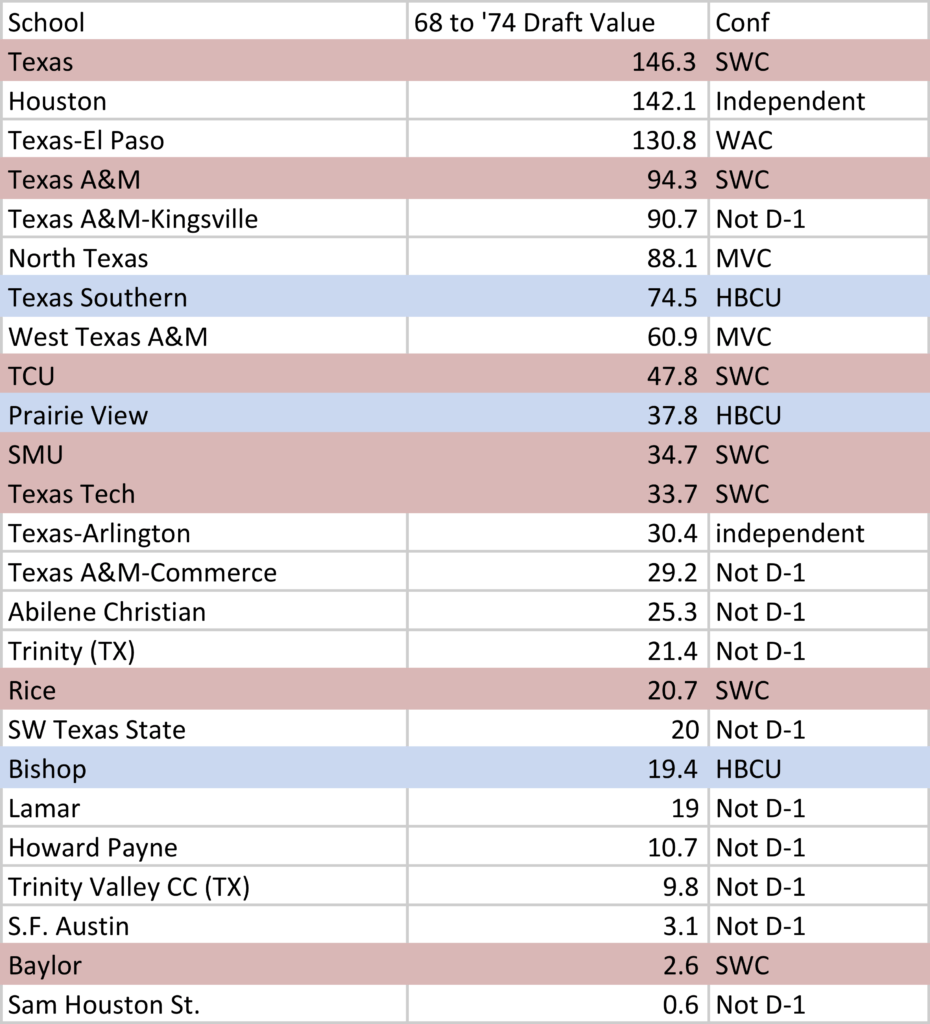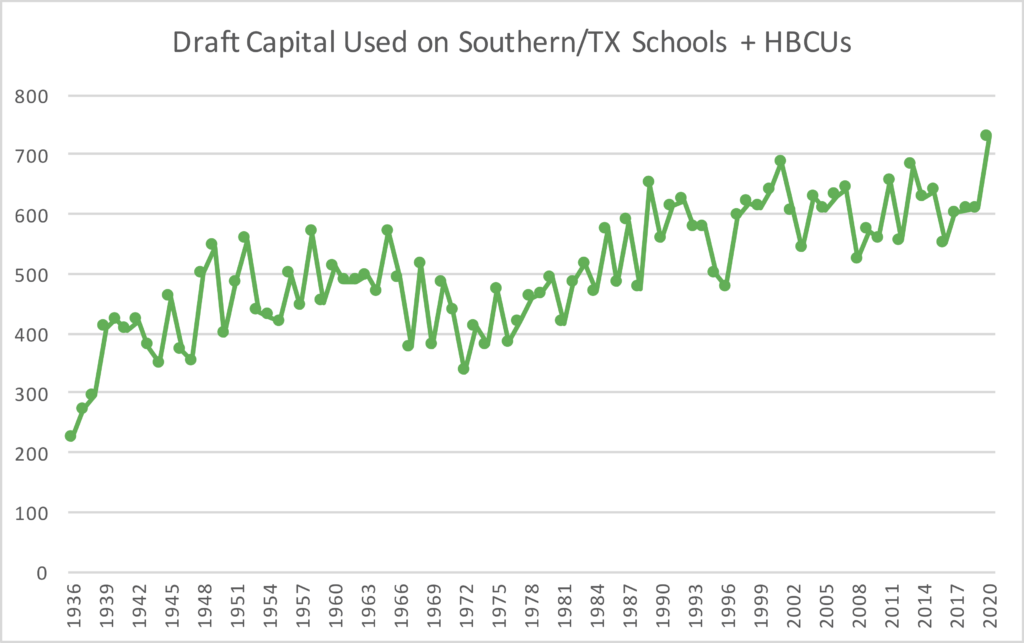For purposes of today’s post, I am defining major college football programs in the South and Texas as the schools in three major conferences. These 30 schools represent most of the major college football programs in the South, Southeast, and Texas. However, I am going to exclude the “northern” schools from these conferences, for reasons that will soon become clear.
The three conferences are the SEC, the ACC, and the former Southwestern Conference (the SWC). The 30 schools are:
- 13 of the 14 current SEC schools, excluding Missouri. [1]These include all 10 schools in the SEC as of the late 1960s, plus three schools that would otherwise qualify anyway: South Carolina (then in ACC), Texas A&M (then in the SWC), and Arkansas (then … Continue reading
- 11 of the 14 current ACC schools, excluding Syracuse, Boston College, and Pittsburgh. [2]These include all 8 ACC schools at the time other than Maryland (now in the Big 10 and a “northern” school) and South Carolina (included in this analysis by virtue of being in the SEC … Continue reading
- The Texas schools that were in the SWC at the time: that includes these 6 schools: [3]In addition to Texas A&M and Arkansas, which are of course now in the SEC. Texas, TCU, Texas Tech, Baylor, Rice, and SMU.
So why am I excluding the northern schools? They integrated much earlier than the southern schools. Most of the schools in this group of 30 didn’t really integrate until the very late ’60s or early ’70s. Meanwhile, Jim Brown was playing at Syracuse in 1954 and Bobby Grier was famously playing at Pittsburgh at the same time. I also chose to use the old SWC rather than the current Big 12, because that is more reflective of those times. Schools like Nebraska, Kansas, and Missouri were in the old Big 8, but those schools were much better at integration than the old SWC. Also, other schools in Texas, like Houston, were a few years ahead of the Texas schools in the SWC. We will deal with the non-SWC Texas schools at the end.
So now we have our group of 30 schools that were the major college programs in the south or Texas over the last 60 years. And, thanks to yesterday’s work, we have a history of players drafted from HBCUs. So let’s compare: the graph below shows the draft value used on players from these 30 southern schools in red compared to the draft value spent on players from HBCUs in blue. You can see a clear dip in talent in the southern/Texas schools in the late ’60s, and it’s directly related to segregation:
 If ever one graph could show the impact segregation had on the NFL Draft, this is it. These HBCU schools were tiny, and often majority female. And yet they were actually standing toe to toe with these 30 southern schools for about half a decade. In fact, in both 1971 and 1974, more draft capital was used on players from HBCUs than on players from these major programs.
If ever one graph could show the impact segregation had on the NFL Draft, this is it. These HBCU schools were tiny, and often majority female. And yet they were actually standing toe to toe with these 30 southern schools for about half a decade. In fact, in both 1971 and 1974, more draft capital was used on players from HBCUs than on players from these major programs.
Let’s isolate the years 1968 to 1974, which was the height of the HBCU influence on the NFL Draft. During this 7-year period, the 6 schools that had the most draft capital used were, in order: USC, Notre Dame, Penn State, Tennessee State, Michigan, and Ohio State. During this period, Oklahoma ranked 13th, Grambling ranked 14th, and Texas raked 15th. More draft capital was used on players from Southern University, based on Baton Rouge, than on players from LSU. The second and third schools in Mississippi were Jackson State and Alcorn State, putting both HBCUs ahead of Mississippi State and Southern Miss. If we create a draft value chart of these 30 programs plus the HBCUs, we get more of a direct line, which presents a bit of a counterfactual history [4]Of course, this also ignores the players who might have gone to an SEC or Texas school had they been integrated, but instead went to a northern or western school. Or a non-SWC Texas school. of what might have been:
Let’s get to the state of Texas. Because what we find is that while HBCUs like Tennessee State and Grambling were doing very well in SEC country, that wasn’t really happening in Texas. That’s because even though the state was very slow to integrate at the major college football level (essentially the SWC), that wasn’t the case throughout the state. There’s no question that the SWC was the dominant presence in Texas during this period, but there were other schools playing Division I football. The table below shows the draft capital used on players from all Texas schools during this 7-year period:
 The men who integrated football in the state of Texas were Abner Haynes (future AFL MVP) and Leon King, in the late ’50s, at North Texas in 1957. The Mean Green, located in Denton, Texas, were ahead of the time; meanwhile, the Longhorns did not have a black player until 1970.
The men who integrated football in the state of Texas were Abner Haynes (future AFL MVP) and Leon King, in the late ’50s, at North Texas in 1957. The Mean Green, located in Denton, Texas, were ahead of the time; meanwhile, the Longhorns did not have a black player until 1970.
Some of the HBCUs in Texas did well: Texas Southern and Prairie View were producers of NFL talent. But a lot of black high school athletes in Texas in the late ’60s were going to Houston, Texas El-Paso, Texas A&M-Kingsville, and North Texas. During this 7-year window, a few of the stars from these schools were Joe Greene came out of North Texas, Harvey Martin out of Texas A&M-Commerce, Riley Odoms from Houston, and Mercury Morris from West Texas A&M; but there were many others. The non-SWC schools in Texas integrated earlier than the SWC schools, which probably hurt Texas Southern and Prairie View relative to its rivals in Mississippi, Louisiana, and Tennessee.
The Best Draft Classes From HBCUs
Finally, let’s close with a look at Tennessee State’s 1974 draft class, which had Too Tall Jones (1st overall), Waymond Bryant (4th), John Holland (29th), Greg Kindle (33rd), and Carl Wafer (42nd) all get drafted in the top 45 picks! From 1968 to 1974, this was the second best draft class by any school at any level, behind only USC’s 1968 class.
Grambling’s best class came in 1971, when Richard Harris (5th) and Frank Lewis (8th) went in the top 10, Sam Holden, Scott Lewis, and Virgil Robinson went in the top 50, and Joe Carter and Willie Armstrong went in the first 110 picks.
As always, please leave your thoughts and questions in the comments.
References
| ↑1 | These include all 10 schools in the SEC as of the late 1960s, plus three schools that would otherwise qualify anyway: South Carolina (then in ACC), Texas A&M (then in the SWC), and Arkansas (then in the SWC). |
|---|---|
| ↑2 | These include all 8 ACC schools at the time other than Maryland (now in the Big 10 and a “northern” school) and South Carolina (included in this analysis by virtue of being in the SEC now), plus Louisville (then MVC) and the four schools that were independent at the time — Florida State, Virginia Tech, Miami, and Georgia Tech. |
| ↑3 | In addition to Texas A&M and Arkansas, which are of course now in the SEC. |
| ↑4 | Of course, this also ignores the players who might have gone to an SEC or Texas school had they been integrated, but instead went to a northern or western school. Or a non-SWC Texas school. |

